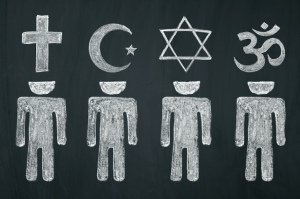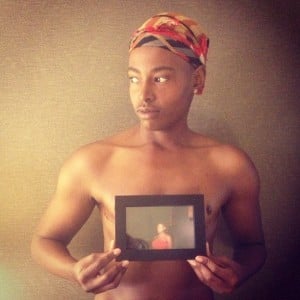
Source: Huffington Post
I am a teenager at the airport. I really want the airport sushi, but I don’t want to be that Asian person who, of course, orders sushi and is good at math and speaks with a foreign accent and…
The decision is too overwhelming. I grab a nice chicken sandwich instead.
I am an undercover Asian.
I spoke Mandarin, looked exactly like the full-blown Chinese teenager I was, and was described as “the whitest Asian girl I have ever met” by the kids at my school.
I was what pop-culture called a banana: yellow on the outside, but white on the inside.
This meant that I had the type of exterior on which people would project a million stereotypes about East Asians.
But, if you were to split me open, I was just another typical “American” girl who said “like” a lot, swooned over ‘NSync, ate Pop Rocks (wow, did I just totally give away my age?), and did everything else I could to fit in.
Because I grew up in a community where Asians were rare, it was tough. I got a lot of stares and double takes. People always gawked at my family when we went out, sometimes going as far as to ask where we came from — surely further east than down the street.
As a kid, I knew that the only way I could stop this was to somehow erase the parts of me that were perceived as Asian. I thought that I needed to be white.
But since I couldn’t be white, I had to do the next best thing: assimilate into the culture around me. I had to adopt the mainstream American culture as my own.
Yet I was constantly reminded of my Asian-ness. I was “the first Asian person I’ve met” and “the first Asian girl I’ve ever dated” for many people.
Damn, I’m your “first Asian girlfriend?” What does that even mean? I’m freaking out because you’re my first boyfriend ever, and I have to deal with this shit, too? Do I speak up for myself when you make a racist joke, or do I come off as a Dragon Lady? Do I not speak up, or do I become the blushing geisha?
Ugh, my heart is racing just remembering those feelings.
I was already busy navigating what it meant to actually be in a relationship, and suddenly, I was also assigned to represent Asia (like the whole freaking continent).
The pressure to be both an ambassador for my ethnic group and a “normal” (read: white) teenager was suffocating me.
It was a daily struggle to figure out who I was and how to present myself to the world. That hyphen in Asian-American seemed more like a shaky tight rope, and it felt safer to live undercover than expose myself to the pressure.
I’d like to say that, as a 30-year-old grown ass woman, I am no longer an undercover Asian. But I can’t. Even though I know these ridiculous anxieties are harmful to my self-worth, I sometimes still let them rule my decisions. I’m not perfect.
But what I do know is that there’s a name for my anxiety: internalized racism. And as soon as I name my oppressor’s tool, I can begin to overcome the oppression.
Internalized racism, according to Donna Bivens, is the process where people of color develop beliefs and behaviors that collude or support the institution of racism. Internalized racism is a form of systematic oppression where people and communities of color unconsciously support white privilege and power.
Because the system of power consistently rewards those who support the racial hierarchy through a false sense of acceptance, communities of color are encouraged to perpetuate a culture that oppresses them. Because of this cycle, internalized racism can have deep psychological effects on communities of color.
For years, I struggled with these psychological battles.
And it was only through love – both the love I developed for myself and the love I received from my friends and family who supported me through this emotional journey – was I even able to begin the process of wrestling with my own internalized racism.
Too heavy? Let me break it down by sharing the lessons I learned about internalized racism.
1. Internalized Racism Was the Price I Paid for Assimilating
For me, internalized racism happened when I adopted the prevailing idea that certain racial and ethnic groups were better than others.
As an Asian-American girl growing up in a predominately white community, I thought that my white classmates were inherently better than me.
I received thousands of messages over the years that I didn’t fit in. My internalized racism did not happen over night.
Until the second grade, my first language was Mandarin. I was that Chinese girl who had few friends – because nothing made sense. Everyone spoke too quickly.
So my ultimate decision to stop speaking Mandarin was not sudden. It was a calculated move. I had worked hard to learn English. It was a decision that roosted in my heart, waiting.
My assimilation began the day I decided that rather than speaking Mandarin, the language of my parents and ancestors, I would lather my thoughts and ideas in American English instead.
Assimilation isn’t just adapting to the mainstream culture. Assimilation is when you lose touch with your own culture and start overvaluing the dominant culture.
For me, assimilation meant giving up an important part of my identity, and, yet, it also meant freedom from isolation.
Not only did I believe those messages that race can determine someone’s self worth, I was applying these hurtful messages to myself.
I was so affected by internalized racism that I became its number one spokesperson. I criticized my parents’ accents because I was horrified that they would embarrass me. I didn’t want to be seen as an immigrant, and I was scared that my parents – in their insistence to be their very Asian selves – would blow my cover.
So my teenage outbursts were seldom about boys or the freedom to hang out with friends past curfew.
My outbursts were latent with unspoken hatred toward myself, my family, and this ever-present Asian identity that prevented me from being the person I thought I should be.
I slammed my door and gave snappy responses because it was easier than admitting “I hate myself and everyone who loves me.”
It was easier to support my oppression. Internalized racism was compulsive, like an addiction that, regardless of how much it made me hate myself, I kept going back to for more.
It made it so that I didn’t have to try to love myself; I could just give in and be what this white supremacist society said was lovable.
I was haunted by this chant in first grade: “Me Chinese, me play joke. Me pee pee in your Coke.” I was haunted by the woman who asked my friend: “Does she speak English?” because my silence couldn’t just be a symptom of shyness.
The more I internalized those messages, the more I hated myself.
I pushed away my family and culture. I became dependent on a system built on hate, a system that would rather turn me into a joke than see me as a fully actualized human worthy of respect and dignity.
Internalized racism was the tool I used to overcome my bad memories. Rather than face the daunting task of teaching society to love me (or even, loving myself when society refused to figure out how), I could transform myself into what society seemed to already love.
But internalized racism doesn’t erase these stereotypes. Internalized racism is like a dirty mop that only spreads the racism around.
I had become a tool for racism and refused to associate with other Asian people.
Further, I pushed this racial hierarchy on other people of color as well. And yes, people of color can tear each other down, too.
My “whites only” attraction neatly disguised my distaste for all men of color. At the time, I didn’t see this attraction to white men as a product of racism; it was simply my preference. But I had learned this preference somewhere.
In fact, colorism – or the idea that lighter color skin is more attractive – is a remnant of colonialism, where the conquered are seen as lesser, uncivilized, and undesirable. Over time, colonialism takes you down psychologically.
That’s internalized racism at work. This self-hate has been passed down over so many generations that we actually have people who say (and think) shit like “You’re pretty good-looking for a dark girl” and “I can’t bring home a black guy.”
My desire to be more white was also my way of supporting the racial hierarchy.
I had become my own oppressor. (Or at least some version of Bobby Jindal.)
I was thinking like a white supremacist (in an ironic sort of way), and that needed to stop.
2. It Took Me 20 Years to Recognize My Internalized Racism
I attended a pretty diverse university where, for the first time, I encountered a plethora of other people of color who felt safe, comfortable, and empowered being themselves culturally and existing in a community with each other.
Suddenly, my internalized racism felt silly. I was reminded of how much I missed myself and my culture.
I started becoming friends with people who happened to be Asian. (I say that they “happened to be Asian” because I had finally decided to look past race and look for good friendship instead.) I finally dated my first non-white guy.
When I started seeing people for who they were rather than what they represented, I realized that that was all I wanted for myself while growing up.
Instead of searching for liberation, I became complacent with a system that punished me for what I represented. Instead of identifying my oppressor, I identified with my oppressor.
3. I Decided to Relocate So That I Could Heal from My Internalized Racism
For me, choosing to relocate to Hawaii after college was the best decision of my life. Though it would bring me to the other side of the world, I knew that I needed to immerse myself in a culture where people looked like me. I knew my way of thinking was beyond unhealthy.
This decision scared me, but it also excited me. I had deliberately shut out a part of myself and now I was finally allowing myself to see it.
In Hawaii, I taught middle and high school math. Most of my students were of Asian backgrounds, but none of them really fit my own stereotypes. I had students who were nerds, preps, goths, jocks, band geeks, dropouts, and stoners – being Asian wasn’t equivalent to a single identity.
Over time, I stopped rejecting my Asian-ness, because what was the point? Who was this performance for?
In retrospect, I don’t think I really needed to move to Hawaii. I was already in the midst of a transformation. I was embracing “new experiences” that really weren’t that new. I was finally saying “yes” to who I truly was.
I was me. My Asian-ness was only one part of me. I only needed to be true to myself.
4. I Choose to Live My Truth – I Choose to Love Myself
W.E.B. Du Bois describes internalized racism as a “double consciousness” where we look at ourselves through the eyes of others. We look with pity and contempt because we can never measure up.
We become our own oppressor – because we hold the keys to our own shackles.
I had wasted so much time trying to be someone I thought I ought to be when was already so perfect as myself.
I moved to Hawaii to be a math teacher. But before I moved, I joked about that a lot. Haha, I’m Asian. Of course I teach math. This joke meant nothing in Hawaii – because most people are Asian, and Asian teachers teach all sorts of subjects.
I am back on the East Coast now, and I still teach math. I can’t say that I am not aware of the stereotypes, but I can say that it bothers me less.
This is who I am! I am good at math, and I actually really enjoy it. I am alright at driving, but mostly I am just too careful. I am great in English Literature, and I actually minored in English.
I can speak Mandarin, and I am not ashamed about speaking it in public anymore. (Screw the ignorant people who think I am a foreigner. This stereotype no longer bothers me because I know there is no shame in being a foreigner. I can speak two languages. It’s a talent to envy, not a skill to be suppressed.)
And I love airport sushi. I get it every time.
[do_widget id=”text-101″]
Amy Sun is a Contributing Writer for Everyday Feminism. She has worked with providing resources and support for Asian/Pacific Islander survivors of domestic violence in the DC, Maryland, and Virginia areas. She also holds her Masters in Women’s Studies from the George Washington University, where she has researched the coming out processes for trans people who identify as FTM and MTF. In her past life, she was a middle and high school math teacher.
Search our 3000+ articles!
Read our articles about:
Our online racial justice training
Used by hundreds of universities, non-profits, and businesses.
Click to learn more




















